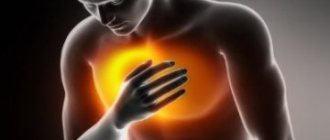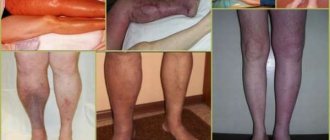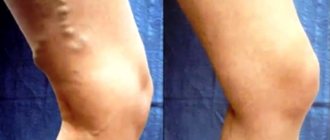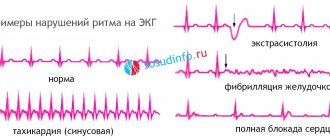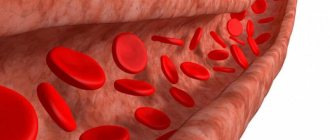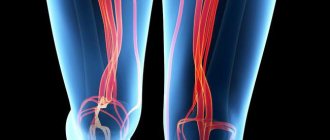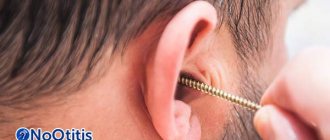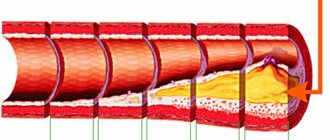Features of the disease
This pathology can progress very quickly, in some cases even at lightning speed, or it can develop more slowly and “calmly.”
Periarteritis nodosa is localized in the following groups of organs and systems:
- In the most difficult cases, the carotid arteries and other large vessels become inflamed.
- In some cases, the blood circulation of the skeletal muscles, pancreas, adrenal glands and stomach is affected.
- Most often, the disease progresses in the vessels of the heart, kidneys and mesentery.
The mesentery is a structure that attaches the intestines to the abdominal cavity. It contains, among other things, arteries necessary for feeding the intestines.
Statistics show that men experience such vascular inflammation approximately 2.5 times more often than women. Patients are usually over 35 years of age but under 45.
With this pathology, the prognosis is extremely disappointing: at best, the person remains disabled, at worst, he may lose the functionality of some organs and even die.
Treatment methods are developing every year, so sometimes it is possible to achieve remission, but due to the aggressive nature of the disease, it is still impossible to completely cure it.
Therapy
At the acute stage of the disease, treatment begins with strict bed rest. The child remains in this mode until he feels better and the following indicators improve:
- pain syndrome will decrease;
- body temperature stabilizes;
- the performance of internal organs will improve.
After this, the baby is placed on semi-bed rest and his health condition is monitored very carefully. If there are no negative changes, then a general regimen is prescribed. The child is allowed to walk in the fresh air, read books and gradually return to their previous lifestyle. Patients in critical condition are prescribed a special diet. These restrictions do not apply to children suffering from a milder form of the disease. The main therapy for getting rid of periarteritis nodosa, as well as improving blood flow and destroying the immune inflammatory process, occurs with the help of medications. For this, the following groups of drugs are prescribed:
- corticosteroids;
- non-steroidal anti-inflammatory drugs;
- anticoagulants;
- symptomatic remedies.
Corticosteroids
Drugs in this group help eliminate the inflammatory process as quickly as possible and also have immunosuppressive properties. Widely used are:
- prednisolone;
- dexamethasone;
- triamcinolone.
The drugs are used for a long time and help eliminate:
- arterial hypertension;
- retinopathy;
- renal failure.
The dose and number of doses are prescribed individually by the doctor for each child.
NSAIDs
To speed up recovery and increase the effectiveness of corticosteroid drugs, non-steroidal anti-inflammatory drugs are prescribed such as:
- butadione;
- indomethacin;
- cyclophosphamide;
- azathioprine.
Anticoagulants
Medicines that improve blood circulation and hyperbaric oxygenation. The following medications are prescribed:
- heparin;
- xavin;
- complamin;
Symptomatic remedies
The use of these medications is prescribed in cases of pronounced symptoms that the baby is unable to tolerate. For example, for very severe pain, narcotic drugs can be used. Children with high blood pressure are prescribed the following medications to help normalize it:
- Methyldopa;
- Clonidine;
- Luminal;
- Furosemide.
Why might it occur?
The reasons why periarteritis nodosa develops have not been fully determined.
There are only a few theoretical assumptions:
- The man suffered from syphilis.
- The vessels were mechanically damaged.
- The patient suffered an acute bacterial infection.
- The walls of blood vessels were exposed to alcohol and other chemical destructive substances.
- The patient has a special structure of the body, which is expressed in hypersensitivity and susceptibility to vascular lesions.
The pathogenesis of the disease - its speed of development and damage to a large number of arteries at once, suggests that the viral hypothesis regarding the occurrence of inflammation is correct.
People with hepatitis B and immunodeficiency virus, as well as those who have had rubella, influenza and other infections (for example, cytomegalovirus or Epstein-Barr) are more susceptible to the formation of antigen-antibody complexes that damage the artery walls.
This is what causes arterial necrosis and subsequently organ failure.
Periarteritis nodosa also occurs in children - its manifestations in this age group are often triggered not only by viruses, but also by food allergies and diathesis.
In adults, the risk group, in addition to those who have had viral infections or suffer from them chronically, includes asthmatics, people susceptible to dermatitis, as well as patients with cardiac ischemia and hypertension.
Periarteritis nodosa in children
Periarteritis nodosa is a very dangerous disease that affects the walls of small or medium-sized arteries, resulting in the appearance of nodules and aneurysms.
Periarteritis nodosa in children is very rare and often occurs before the age of 10 years. This disease affects girls more often than boys.
In this article we will talk in detail about the causes, symptoms, methods of treatment, as well as preventative measures that will help avoid the occurrence of the disease.
Causes
Periarteritis nodosa can occur and develop due to the following factors:
- long-term use of medications;
- grafting;
- various diseases (ARVI, Hepatitis B).
In addition, the state of the immune system and its ability to fight various harmful microorganisms play an important role. The disease very often occurs in children who are allergic to certain foods and medications. The disease can also be transmitted at the genetic level. Particular attention is paid to the following diseases:
- asthma;
- angina pectoris;
- hypertension;
- endarteritis.
Kinds
In medical practice, the disease, depending on its location, is divided into the following types:
- peripheral vascular damage;
- damage to internal organs.
The division also occurs depending on the course of the disease into:
- spicy;
- subacute;
- chronic.
Acute
From the first days of the development of the disease, the child’s condition was very serious. The disease begins with the following pronounced symptoms:
- body aches and fever;
- profuse sweating;
- severe pain;
- rapid vascular damage;
- development of necrosis on the skin.
This condition can last for about a year.
Subacute
The disease progresses smoothly. At first, the symptoms are not very pronounced, but over time they gain momentum and make themselves felt. A subacute condition is often observed when internal organs are damaged. At first, the patient is sometimes worried about:
- headache;
- increased body temperature;
- weight loss;
- joint pain.
Over time, the symptoms worsen and become an acute form of the disease.
Chronic
This condition occurs during both acute and subacute development of periarteritis nodosa. There is a frequent change of periods of exacerbation and lull of the disease.
Symptoms
The appearance of periarteritis nodosa is accompanied by such main symptoms as:
- a strong increase in body temperature;
- pain in the joints and muscles;
In addition, accompanying syndromes also occur:
- cutaneous and thromboangiitis;
- neurological;
- cardiac;
- abdominal;
- renal;
- pulmonary.
At an early age, the disease has very pronounced clinical signs, quickly progresses, affecting blood vessels, and causes necrosis of the skin. As a result, gangrene and infarction of important organs may develop.
It all starts with an increase in body temperature; it reaches 38°C, and sometimes 39°C, and may not decrease for a long period of time. The baby sweats a lot and often and loses body weight. Severe weakness of the body and drowsiness occurs.
In addition to all this, clinical syndromes begin to develop. They arise differently for everyone.
Skin syndrome
This syndrome occurs in almost every second baby with periarteritis nodosa. Spots appear on the skin - livedo, which are very similar to tree branches. They are localized mainly on the upper and lower extremities, but there are cases of their appearance on the skin of the face and chest.
The spots have a bright color and do not disappear from the skin for a long time. Only in the stage of deep remission their color fades and becomes not very noticeable to others. In areas where livedo has occurred, you can feel nodules of various sizes that surround the vessels. Swelling develops in the areas of large joints, causing discomfort and pain.
Necrotic processes may occur in these areas.
Thrombangiitis
Severe attacks of pain occur in the legs and arms. Increased pain occurs at night. Because of this, the child loses sleep and becomes very moody. Painkillers provide pain relief only for a short period of time. Prolonged pain leads to swelling, decreased blood flow and numbness in some areas.
Neurological
Damage to the nervous system occurs due to changes in blood vessels in the brain and spinal cord. A cerebral vascular crisis occurs, which is accompanied by the following symptoms:
- dizziness;
- headache;
- nausea and vomiting;
- loss of consciousness;
- increased blood pressure;
- convulsions.
Cardiac
Internal organs suffer greatly when this disease appears, especially the heart. As a result, coronary artery disease, myocardial infarction, myocarditis and pericarditis may occur. The organ increases in size under the influence of the disease, tachycardia and various noises occur. You can see all these changes using various types of research:
- electrocardiographic;
- phonocardiographic;
- ultrasonic
Abdominal
Acute pain occurs in the abdominal cavity, significantly increasing with palpation of the abdomen. If treatment is not timely, ulcers, intestinal necrosis, and inflammation of appendicitis may appear. In some cases, a very dangerous phenomenon occurs - bleeding in the intestines, which can lead to the death of a small patient.
Renal
It occurs extremely rarely than other syndromes. For example, with high blood pressure, blood circulation in the brain is disrupted. Severe arterial hypertension occurs, which can result in cerebral hemorrhage and kidney rupture.
Pulmonary
When pulmonary syndrome occurs, asthma and pulmonary infarction may occur. These diseases occur more often in adults and very rarely in children. With the development of pulmonary syndrome, breathing problems occur and a cough appears.
Diagnostics
Making a diagnosis at the first signs of the disease is not easy. To achieve this, special attention is paid to:
- body temperature;
- presence of livedo;
- pain;
- the presence of nodules;
- condition of mucous membranes;
- presence of syndromes.
To determine it, a diagnostic method such as a biopsy is used. A piece of the affected piece of skin and muscle is taken.
Then the tissue is examined under a microscope.
However, in cases where there is no skin syndrome, changes will not be detected in the tissues and this diagnosis is ineffective.
Therefore, to diagnose periarteritis nodosa, aortography is used.
Before the procedure begins, a special substance is introduced into the body to facilitate a better image of the vessel on the monitor screen.
Doppler ultrasound (USD) of the renal vessels helps to identify various anomalies, as well as to study renal blood flow and the state of microcirculation.
In addition, laboratory testing is carried out. To do this, a blood and urine test is performed. A general urine test is a primary examination; despite the ease of implementation, it is very informative. To perform the analysis correctly, you need to perform the following steps:
- Before performing the procedure, you need to wash your genitals well;
- urine is collected early in the morning;
- The test vessel must be clean and dry.
Blood analysis
The procedure is carried out in the morning and on an empty stomach. A blood test is taken to determine the following indicators:
- mild normochromic anemia;
- leukocytosis;
- thrombocytosis;
- increase in ESR;
- creatinine content;
- urea;
- C-reactive protein;
- alkaline phosphatase;
- liver enzymes;
- bilirubin.
Therapy
At the acute stage of the disease, treatment begins with strict bed rest. The child remains in this mode until he feels better and the following indicators improve:
- pain syndrome will decrease;
- body temperature stabilizes;
- the performance of internal organs will improve.
After this, the baby is placed on semi-bed rest and his health condition is monitored very carefully. If there are no negative changes, then a general regimen is prescribed. The child is allowed to walk in the fresh air, read books and gradually return to their previous lifestyle.
Patients in critical condition are prescribed a special diet. These restrictions do not apply to children suffering from a milder form of the disease.
The main therapy for getting rid of periarteritis nodosa, as well as improving blood flow and destroying the immune inflammatory process, occurs with the help of medications. For this, the following groups of drugs are prescribed:
- corticosteroids;
- non-steroidal anti-inflammatory drugs;
- anticoagulants;
- symptomatic remedies.
Corticosteroids
Drugs in this group help eliminate the inflammatory process as quickly as possible and also have immunosuppressive properties. Widely used are:
- prednisolone;
- dexamethasone;
- triamcinolone.
The drugs are used for a long time and help eliminate:
- arterial hypertension;
- retinopathy;
- renal failure.
The dose and number of doses are prescribed individually by the doctor for each child.
NSAIDs
To speed up recovery and increase the effectiveness of corticosteroid drugs, non-steroidal anti-inflammatory drugs are prescribed such as:
- butadione;
- indomethacin;
- cyclophosphamide;
- azathioprine.
Anticoagulants
Medicines that improve blood circulation and hyperbaric oxygenation. The following medications are prescribed:
- heparin;
- xavin;
- complamin;
Symptomatic remedies
The use of these medications is prescribed in cases of pronounced symptoms that the baby is unable to tolerate. For example, for very severe pain, narcotic drugs can be used. Children with high blood pressure are prescribed the following medications to help normalize it:
- Methyldopa;
- Clonidine;
- Luminal;
- Furosemide.
Prevention
Periarteritis nodosa is a chronic disease and cannot be completely cured. After a properly selected course of treatment, he goes into a calm stage, which can last from a year to ten. In medical practice, cases of death of children from this disease have also been recorded.
Therefore, after suffering from this disease, it is necessary to register and periodically conduct an examination of the body, namely blood vessels and organs, in order to avoid the progression and spread of the disease.
Specialized medications and vitamin complexes are also prescribed to maintain normal functioning of the body.
Source: https://nogi.guru/zabolevaniya/uzelkovyj-periarteriit-u-detey.html
How do blood vessels change?
An allergen or virus entering the body causes a response from the immune system, after which the process progresses into the autoimmune phase and begins to affect the body’s tissues along with the negative substance entering the blood.
The formation of complexes from the proteins of the vessel walls occurs. These complexes become targets for immune cells.
By attacking the tissues marked in this way, they destroy the wall of the vessel, causing its narrowing and necrosis. Elasticity is lost, the blood forms vortices (almost knots), and stagnates in certain areas. The regulation of blood flow is disrupted.
As a result: from such an “interruption” in the supply of blood and blockage of blood vessels, the internal organs of a person do not receive the necessary nutrients. As the disease progresses, their partial atrophy begins.
Causes
The causes of vascular periarteritis nodosa are not clear. But, theoretically, 5 reasons have been derived that are not confirmed in medical practice:
- Syphilis of the arteries.
- Mechanical damage to blood vessels.
- Intoxication.
- Bacteria.
- Sensitivity to something.
Now doctors are more inclined to consider viral infections - influenza, hepatitis C, B, AIDS and other infectious diseases.
Factors of the disease are:
- Allergic reactions to medications;
- Failures in the immune system;
- Irradiation of the body;
- Long stay in the cold;
- Congenital predisposition.
People develop super sensitivity, which is delayed. An antigen appears in the body, to which the body produces antibodies in the blood. In the process, everything settles on the walls of blood vessels and affects them.
A large percentage of the risk of the disease are children with diathesis, allergies to food, and allergies to medications. Adults who have asthma, problems with the vascular and cardiac systems, and pressure surges.
Possible shapes and types
Polyarteritis nodosa, or, as it is also called, periarteritis nodosa, has several recognized clinical forms:
| Type | Peculiarities |
| Classic (renal-visceral, renal-polyneuritic forms) | Affects the kidneys, central nervous system, peripheral nervous system, heart and digestive organs. |
| Monoorgan nodular | The least pronounced form, affecting several organs at once. |
| Cutaneous thrombangic | A benign disease that progresses very slowly, but is accompanied by arterial hypertension, neuritis and impaired blood flow in the extremities due to nodules along the vessels. |
| Asthmatic (pulmonary vasculitis) | Accompanied by bronchial asthma and lung damage. |
According to the international classification ICD-10, nodous vascular inflammation is in class M30 with the following clarifications:
- M30.1 is an allergic form that affects the lungs.
- M30.2 – juvenile form.
- M30.3 – Kawasaki syndrome (damage to mucous membranes and skin).
- M30.8 – any other conditions.
There are also several types into which polyarteritis nodosa is divided depending on the nature of the disease:
- Fulminant - primarily affects the kidneys. Malignant pathology causes thrombosis of intestinal vessels, with necrosis of its loops. Extremely unfavorable prognosis: life expectancy - up to a year.
- Fast - lasts a little slower, but affects the same areas as lightning. The survival rate is low because it results in sudden rupture of the renal artery.
- Relapse - if the patient takes the medicine and undergoes therapy, the disease ceases to manifest itself, but regains its progress from reducing doses or contracting another infection. By the end of the 5-year period, 13% of patients survive without treatment and 40% survive with treatment.
- Slow - usually this is the thromboangitic form. Affects peripheral nerve trunks and vessels of the extremities. The disease can progress over 10 years or more if there are no additional complications. The person remains disabled and is forced to undergo constant treatment.
- Benign - a “mild” form of the disease, isolated. Localized only on the skin, subject to long remission. The survival rate is quite high with proper treatment.
Only benign periarteritis is more or less treatable - you can live with it for many years, maintaining activity and continuing to work. The remaining cases are clinically severe and require ongoing treatment.
That is why people with this disease have to register for disability; their legal capacity is reduced to the point of complete incapacity for work.
Classification
In the clinical course of periarteritis nodosa, there are several options:
- classic (with renal polyneuritic or renal visceral symptoms);
- asthmatic;
- monoorgan;
- cutaneous thrombangiitis.
The mildest form of periarteritis nodosa is considered cutaneous , which is not characterized by viceropathies (extensive damage to internal organs). Its main symptom is subcutaneous or skin nodules, which are located on the extremities along the vascular bundle. Patients, to one degree or another, retain their ability to work and social skills; in addition, they often experience persistent remissions.
This photo shows the manifestations of cutaneous periarteritis nodosa:
The photo is not recommended for viewing by the faint of heart and impressionable
Monoorgan nodular periarteritis is distinguished by changes in blood vessels , which are determined by biopsy or examination of a removed organ.
The course of the disease can be benign, slowly progressive, recurrent, rapidly progressive and acute . In particular, slow progression is characteristic of the thromangiitis variant, but the disease in this case can be characterized by arterial hypertension, microcirculatory disorders and peripheral neuritis.
Rapidly progressive periarteritis nodosa is associated with kidney damage and a malignant form of arterial hypertension.
Symptoms and characteristic signs
Symptoms of periarteritis nodosa depend on the localization and spread of inflammation:
- In all forms, the first sign is fever and an increase in temperature - it manifests itself in waves.
- Lethargy and lethargy appear - the patient seems to be on the verge of sleep, in prostration.
- Urine output decreases.
- Severe shortness of breath appears, especially in the asthmatic form.
- Body weight decreases critically over a short period of time, regardless of diet and sports activity.
- The joints begin to ache - arthralgia.
- Deterioration of vision.
- Muscle pain occurs, myalgia is localized in the abdomen or heart when organs in this area are affected, and in the limbs in all other cases.
- I have a constant headache.
External signs occur in every fourth patient and include the following symptoms:
- The rash is lumpy, in the form of red dots or blisters of varying sizes.
- Necrosis is the death of areas of the skin.
- A pattern on the skin in the form of a vascular network or tree branches.
- Death of the phalanges of the fingers.
- Nodular formations under the skin.
- General pallor or even marbled color of the skin.
Cardiovascular insufficiency in this condition can also lead to myocardial infarction, sclerosis, increased blood pressure, and mitral valve insufficiency.
Complications in any form of the disease can manifest themselves in the form of intestinal gangrene, perforation of ulcers, stroke or aortic aneurysm.
Clinic
Among the general symptoms of the disease, the most common and significant are fever, arthralgia, myalgia, and cachexia.
Persistent undulating fever does not respond to antibiotics and disappears after taking glucocorticosteroids.
Cachexia and progressive weight loss is characterized by a sharp loss of 30-40 kg in a short period of time.
Myalgia and arthralgia occur in the leg muscles and large joints and are accompanied by muscle weakness and atrophy.
In patients, the skin turns pale and acquires a marbled tint. A rash appears on the skin, and subcutaneous painful nodules form in the thighs, legs and forearms, located along large neurovascular bundles, singly or in small groups. These clinical signs are symptoms of the classic form of pathology.
Specific symptoms are caused by damage to internal organs:
- When the coronary arteries are damaged , chest pain occurs, acute circulatory disorders in the coronary vessels, heart failure, cardiosclerosis, and heart rhythm disturbances occur. Coronaritis leads to angina pectoris, myocarditis, arrhythmia, and mitral valve insufficiency. A peculiar coronary pathology can occur without a clear clinical picture with frequent angina attacks. The electrocardiogram shows extrasystoles, paroxysmal tachycardia, atrial fibrillation.
- Damage to the central nervous system in periarteritis nodosa is often combined with inflammation of the peripheral nerves and is accompanied by the development of mono- or polyneuritis, which is manifested by sharp and burning pain in the extremities, paresthesias, and paresis. The pathological process is predominantly localized in the arteries of the lower extremities. The pathology is complicated by the development of strokes, meningoencephalitis, seizures, mental disorders, and hemiparesis.
damage by periarteritis nodosa of the kidneys
When the renal arteries are damaged, patients develop persistent hypertension, protein, leukocytes, casts and blood appear in the urine. In severe cases, rupture of the affected vessel ends with the formation of hematomas in the perinephric tissue. Nephrotic and nephritic syndromes determine the treatment tactics for patients. With periarteritis nodosa, the kidneys are most often affected than all other internal organs. The outcome of vascular lesions of the kidneys is ischemic infarction, post-infarction scars, vasculitis and vascular sclerosis, nephrosclerosis.- Inflammation of the arteries of the digestive tract is manifested by diffuse abdominal pain, tension in the anterior abdominal wall, dyspeptic syndrome - diarrhea with blood and mucus, nausea, vomiting, and lack of appetite. When the liver is involved in the pathological process, hepatomegaly, jaundice, and liver dysfunction occur. Damage to the pancreas clinically resembles pancreatitis with intrasecretory insufficiency. Complications of the disease are: peritonitis, pancreatic necrosis, ulcer perforation, acute abdominal syndrome, jaundice and gastrointestinal bleeding.
pulmonary vascular lesions on a diagnostic imageInflammation of the pulmonary arteries is another clinical variant of periarteritis nodosa. Bronchospasm and infiltration of the lungs with eosinophils occurs. The disease manifests itself with symptoms of interstitial pneumonia, pleurisy or bronchial asthma. Patients develop pulmonary vasculitis, and the pulmonary pattern is deformed. The pathology is manifested by severe cough, shortness of breath, hemoptysis, and chest pain. Percussion reveals a shortening of the percussion tone, alternating with a clear pulmonary sound; auscultation reveals respiratory sounds and wheezing. The pathology is complicated by the rupture of vascular aneurysms and the development of pulmonary hemorrhages. The disease can occur as tuberculous infiltration of the lungs, exudative pleurisy, severe attacks of bronchial asthma, bronchospastic syndrome.
- Nodular arteritis often manifests itself as damage to the eyes with inflammation of various structures of the visual analyzer. Patients develop malignant retinopathy. The vessels of the fundus are dilated and thickened, especially in people with hypertension.
- Damage to the arteries supplying blood to the organs of the endocrine system leads to the development of dysfunction of the gonads, thyroid gland and adrenal glands. Allergic vasculitis is the main pathogenetic link of orchitis and thyroiditis.
The acute course of the disease usually occurs in children, lasts about a month and is characterized by rapid progression of the process with the development of myocardial infarction, cerebrovascular accident or hypertensive crisis. In the subacute course, exacerbations are often replaced by periods of remission. This pathology lasts up to 6 months and occurs quite often. Chronic periarteritis nodosa progresses slowly and takes years to treat.
Periarteritis nodosa in children is characterized by progressive vascular damage and is complicated by the development of necrosis and gangrene of the extremities. The disease most often occurs among girls of any age. The pathology develops acutely. In patients, body temperature rises to 39-40°C, profuse sweating, weakness, and malaise are noted. Persistent, tree-shaped bluish spots appear on the skin against a background of marbled pallor. Subcutaneous or intradermal nodules are usually the size of a bean or millet grain and are palpated along the course of large vessels. Painful, dense swelling is located in the area of large joints; later they either disappear or are replaced by foci of necrosis. Severe paroxysmal pain in the joints is accompanied by a burning or bursting sensation. Sick children sleep poorly at night and become restless and moody. In the absence of timely and adequate treatment, foci of necrosis spread to surrounding tissues.
Diagnostic methods
Polyarteritis nodosa does not have clear enough signs that would help to instantly distinguish it from other diseases of the internal organs.
Diagnosis is carried out comprehensively, based on 10 international criteria for defining this disease:
- Severe weight loss by the patient for no apparent reason.
- Formation on the skin of a cellular or tree-like pattern of bluish color. In medicine, this phenomenon is called livedo reticularis.
- The presence of myalgia - weakness and pain in the lower extremities. Shoulder and lower back pain are not considered a symptom.
- Damage to peripheral nerves - one or several at once.
- When measuring blood pressure, an increase in lower pressure above 90 mm Hg is observed. Art.
- Presence of hepatitis B antigens or antibodies in the blood.
- Elevated levels of urea and creatinine in the blood.
- Men experience pain in the testicles and their increased sensitivity.
- Angiography - during this procedure, blood clots and aneurysms of arteries located close to internal organs are detected.
- A biopsy of the vascular wall is what ultimately determines the presence of inflammatory infiltration and the degree of necrosis. The tissue sample obtained through this study shows traces of infiltration of granulocytes, mononuclear cells and leukocytes.
The presence of three signs from this list is sufficient for the diagnosis to be confirmed.
In addition, the patient is prescribed the following tests and diagnostic procedures:
- Urine analysis for the presence of protein and red blood cells.
- Blood test - general, biochemical and for the presence of HBsAg.
- Ultrasound of the heart, ECG - to exclude pathologies of this organ.
- X-ray of the lungs in the presence of asthmatic manifestations.
The study of all the features of the condition as a whole allows us to accurately diagnose the presence of one of the forms of periarteritis nodosa.
Diagnostics
Laboratory and instrumental studies are mandatory for diagnosing this disease. After a personal examination and identification of symptoms in the patient, he is prescribed laboratory tests - a general urine and blood test. In addition, the following is carried out:
- muscle tissue biopsy;
- CT scan of the abdominal cavity (if there is a suspicion of gastrointestinal lesions);
- angiography of internal organs;
- biopsy of the intestinal mucosa.
Bowel biopsy using an endoscope
Only after a complete diagnosis can a course of treatment be prescribed.
Diagnosis of periarteritis in the early stages is very difficult, since symptoms and tests may indicate another disease - renal failure, heart attack or cardiac arrhythmia, heart failure. Therefore, incorrect treatment may be prescribed initially.
How is the treatment carried out?
Treatment of polyarteritis is carried out over several years (depending on the form and severity of the disease):
- Medicines are prescribed - glucocorticoids and cytostatics, as well as anti-inflammatory and vascular-nourishing medications.
- Plasmapheresis and hemosorption are performed.
However, it is impossible to recover completely; you can only delay the progression of the disease.
Drug therapy
First-line drugs are corticosteroids to relieve the acute phase of the disease:
- Prednisolone.
- Dexamethasone.
- Triamcinolone.
They help reduce the intensity of autoimmune reactions - their anti-inflammatory effect has been tested and is very pronounced. The duration of administration is regulated by the doctor, but usually hormonal medications are prescribed for a long period with a gradual reduction in dose.
To enhance the effect, non-steroidal anti-inflammatory drugs are added: aspirin, nimesulide, meloxicam.
To prevent complications, they take cytostatic drugs - Azathioprine, Cyclophosphamide. They work well against malignant hypertension, as well as nephrotic syndrome and kidney damage. In this case, long-term use of cytostatics requires subsequent aminoquinoline therapy - taking the drugs Delagil and Plaquenil.
Also used are drugs that improve blood circulation and prevent the formation of blood clots: Trental, Heparin.
At any stage of the development of the disease, it is permissible to relieve individual symptoms with painkillers and medications that normalize blood pressure.
Additionally, the patient is prescribed vitamins and antihistamines.
An infection on the skin requires antibiotics to eliminate purulent tissue damage.
Plasmapheresis
Used in severe cases. This is a method of purifying blood outside the human body - during the procedure, the blood is pumped out and passes through external filters, and then returned to the vessels. Plasma, which contains bacteria, toxic substances and antibodies to the hepatitis B virus, is removed from the body and disposed of.
The procedure lasts more than an hour. You need to complete 9 sessions over 3 weeks. After this, the regularity is as follows: up to two procedures per week, and from the sixth week - one at a time until the condition improves.
This method is used in combination with medication, regularly maintaining the level of drugs in the blood, since they are “washed out” along with the removed plasma.
Hemosorption
One of the types of adsorption, in which the blood is not separated, as with plasmapheresis, but is passed through a filter with synthetic materials that retain all harmful substances.
Treatment
Treatment of periarteritis nodosa includes a gentle diet. It is filled with calcium salts and vitamins. Necessary for the prevention of stomach damage and osteoporosis.
The main treatment includes the use of glucocorticoid hormones, cytostatics, and plasmapheresis. In the first month, large doses of glucocorticoids are prescribed. Gradually it decreases. Maintenance treatment can be carried out for up to 5 years.
Glucocorticoids must be combined with cyclophosphamides. They are taken in large doses for a couple of weeks, and after remission they come for maintenance therapy. During this period, it can be replaced with less toxic azathioprine or methotrexate.
Treatment for periarteritis nodosa may be prescribed based on symptoms. So, with a rapid increase in honorary insufficiency, plasmapheresis sessions are used. During this procedure, artificial purification of the blood from metabolic products occurs. In the presence of viral hepatitis, lamivudine and interferon are used. During this period, cyclophosphamide is not used.
Surgical intervention is used in cases of intestinal ischemia and necrosis, appendicitis, cholecystitis.
When aneurysms form in the brain, endovascular intervention is used. In this case, microspirals are installed into the lumen of the vessel.
In cases of severe renal failure, kidney transplantation is used.
Forecast
The prognosis for periarteritis nodosa is unfavorable - the patient can live only from one year to 5-10 years, even if this condition is intensively treated.
Complications that arise during this time in internal organs and systems shorten life expectancy: thrombosis, renal failure, cerebral disorders - all of them lead to death.
Only half of the sick are subject to remission, so the disease is generally considered a bad diagnosis.
What is periarteritis nodosa?
Periarteritis belongs to the group of vasculitis (pathologies characterized by inflammation of the walls of blood vessels of various sizes). A distinctive sign of the disease is damage to small and medium-sized arteries (muscular vessels).
The risk group includes the radial, femoral artery, as well as most arteries that supply oxygen and nutrients to the visceral organs (kidneys, liver, intestinal mesentery, heart and central nervous system). Necrotic changes in the wall in polyarteritis nodosa gradually lead to impaired circulation and ischemia of internal organs.
Most often, this disease develops in adult men under 50 years of age. The incidence of periarteritis nodosa in children is low: a rare pathology is found mainly in girls under 10 years of age.
Preventive measures
Prevention of periarteritis has not been developed - you need to avoid those factors that can cause it: protect yourself from viruses, harden the body.
If symptoms are detected, it is necessary to consult a doctor as quickly as possible and then there will be a chance to “catch” the disease at the very start.
Author of the article: Yulia Dmitrieva (Sych) - In 2014, she graduated with honors from Saratov State Medical University named after V. I. Razumovsky. Currently working as a cardiologist at the 8th City Clinical Hospital in the 1st clinic.
